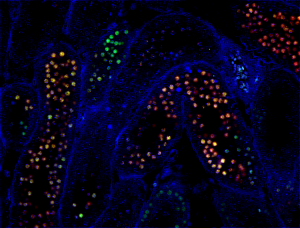
The “histone code hypothesis” proposes that modifications of histones – the scaffold proteins that organise DNA within the cell nucleus – are read in a combinatorial manner in order to control gene activity and DNA metabolism. In the case of DNA damage, two separate modifications of histone H2AX at sites of DNA damage are proposed to interact to form an epigenetic “switch” that determines whether the cell repairs damaged DNA or undergoes apoptosis. This cellular fate choice between life and death in response to DNA damage is critical to all areas of biology, including recombination in developing germ cells, DNA rearrangement in cancer cells, and accumulation of damage in aged cells. Using novel antibodies that selectively recognise the various modification states of H2AX, Dr Ellis is working to understand how DNA damage is detected and repaired in developing sperm cells, and (via collaboration with others in Biosciences) whether these histone modifications are also responsible for drug resistance in cancer cells that have become un-responsive to treatment.